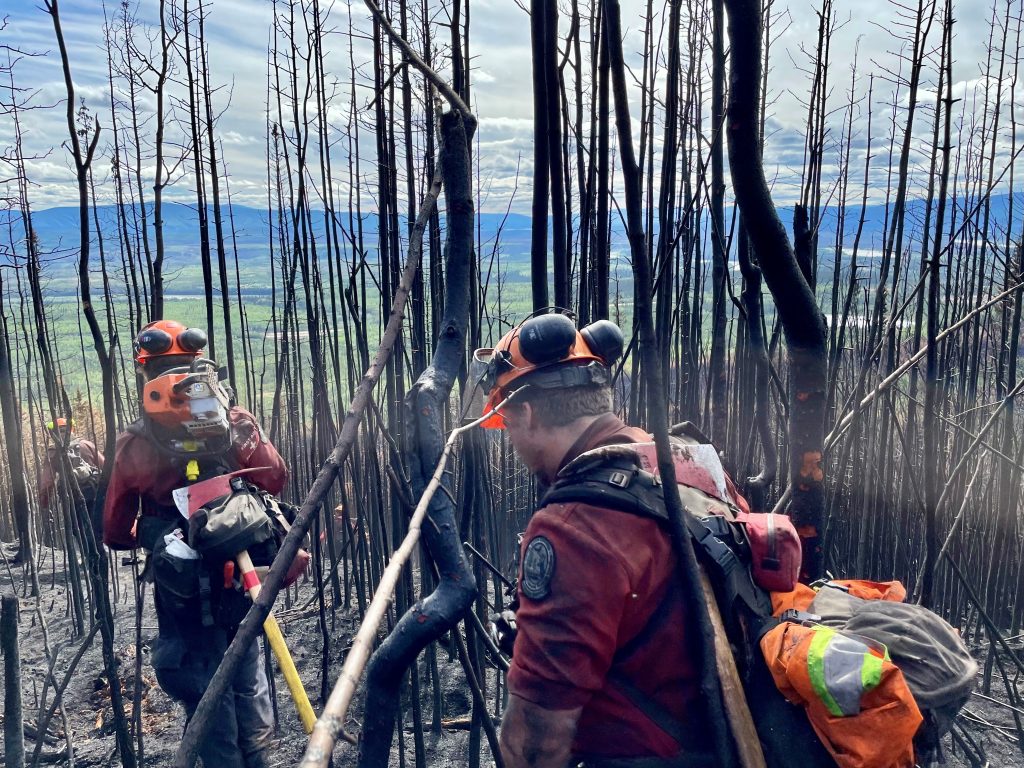In the world of wildland firefighting, relationships with mutual aid partners are essential to success. Wildfires don’t stop at borders and neither does the work of those responding to wildfires or working in wildfire prevention or preparedness.
The 2022 fire season presented many opportunities for the BC Wildfire Service (BCWS) and Yukon Wildland Fire Management to work together for the benefit of people on both sides of the border.

Early in the season, the BC Wildfire Service collaborated with agencies in the Yukon Territory to complete a prescribed burn in Lower Post, B.C. Though Lower Post is in B.C., the community is strongly tied to Watson Lake, Yukon, which is located 20 km northwest.
Wildfire Technician Ian Harris led the operation on behalf of BCWS with cooperation from two Yukon Wildfire initial attack crews, one squad from a Yukon First Nations Wildfire unit crew, members of the Liard First Nation and officers from the respective agencies to support.
“During a trip to Lower Post this spring, a BCWS Wildfire Officer identified areas within the community that had dense matted grass that would benefit from the use of prescribed fire for hazardous fuels mitigation,” said Harris.
“The community supported the idea to have crews come in and burn off the grass. Additionally, this would create an opportunity for inter-agency training between BCWS, Yukon Wildfire, and Yukon First Nations Wildfire.
“BCWS and Yukon Wildfire have mutual aid agreements to increase response effectiveness for fires near the border.”
Less than a month later, the organizations had further opportunity to deepen those working relationships. On June 24, B.C. sent the first wave of firefighters to the territory to assist with wildfire suppression. Throughout the summer more than 250 firefighters and support personnel were deployed to the Yukon. Crews from B.C. were grateful to reciprocate support to the Yukon following the 2021 wildfire season, during which many Yukon firefighters travelled south to assist.

In early July, several lightning-caused fires started in B.C.’s northern Cassiar Fire Zone, just south of the Yukon border. The Tagish Lake wildfire ended up crossing the border, requiring coordination between the two agencies to determine who would take the lead on response.
Meanwhile, another wildfire adjacent to Highway 37 was growing rapidly and was highly visible from Watson Lake, Yukon.
Cal Read is the Watson Lake Regional Protection Manager for Yukon Wildland Fire Management.
“Even though this fire was in British Columbia, it was in Watson Lake’s backyard and looked more imposing because of how visible it was,” said Read. “People get their firewood there; they live and play and hunt there. Dominant westerly winds blew smoke from the fire into the area and created a dark, ominous energy that we needed to manage while Northwest Fire Centre [B.C.] crews managed the fire.”
Add to that, the fact that when the fire started, the Alaska Highway – the only other highway south from Watson Lake – was closed due to a washout. Although the fire was not expected to impact highway 37, residents north of the fire were understandably nervous and needed access to information.
Fire Information Officers from both jurisdictions collaborated to release community bulletins to residents on both sides of the border, sharing pertinent information about the wildfire in B.C.
Through working together this fire season, BCWS and Yukon Wildland Fire Management staff were able to build relationships with one another that will serve both jurisdictions in the years ahead.
To learn more about the 2022 wildfire season, read the season summary.
